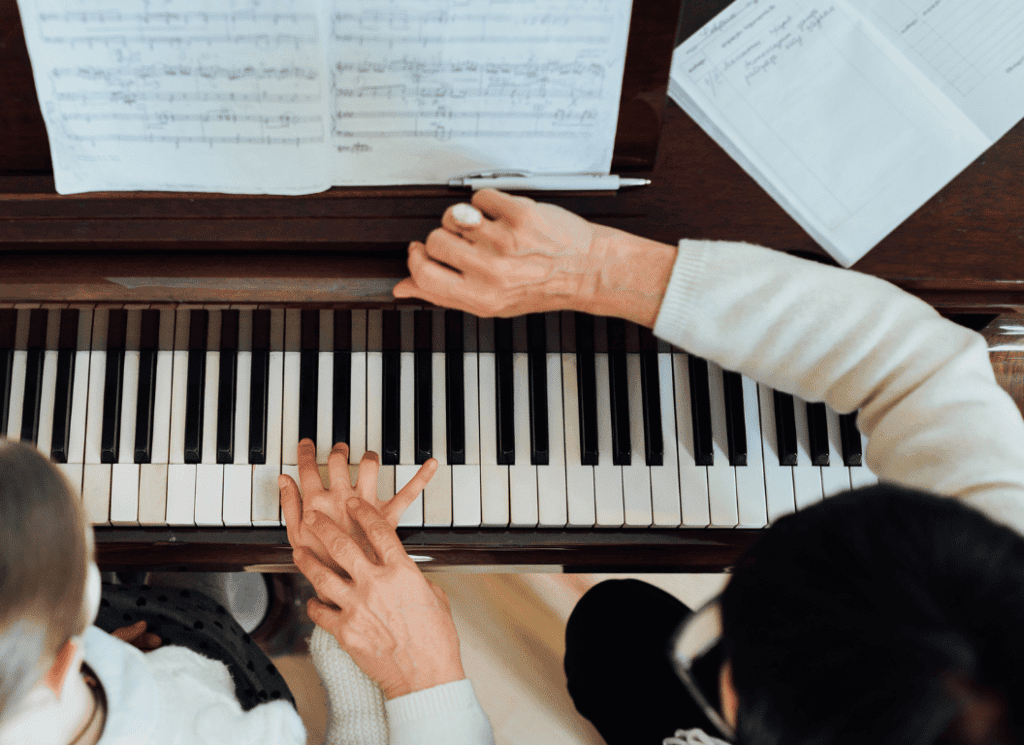Exploring the Role of the Piano in Different Genres of Music
The piano in different music genres tells a story that spans centuries. From grand concert halls to intimate cafés, this instrument has found its voice in every corner of the musical world. Due to its wide range and expressive capabilities, the piano stands out as one of the most powerful tools in a musician’s hands.
Not only does it serve as a solo instrument, but it also fits perfectly into ensembles and modern productions. Because of its ability to adapt, the piano crosses genre boundaries with ease. Whether in jazz clubs, gospel choirs, rock concerts, or electronic tracks, the piano remains an integral part of musical expression.
This blog explores how piano playing styles across various music genres have evolved over time. We’ll look at how it plays a unique role in jazz, blues, pop, classical, gospel, and more. You’ll see how its voice changes to match the mood and spirit of each genre. Get ready to discover the piano’s journey through the diverse world of music.
The Timeless Charm of the Piano
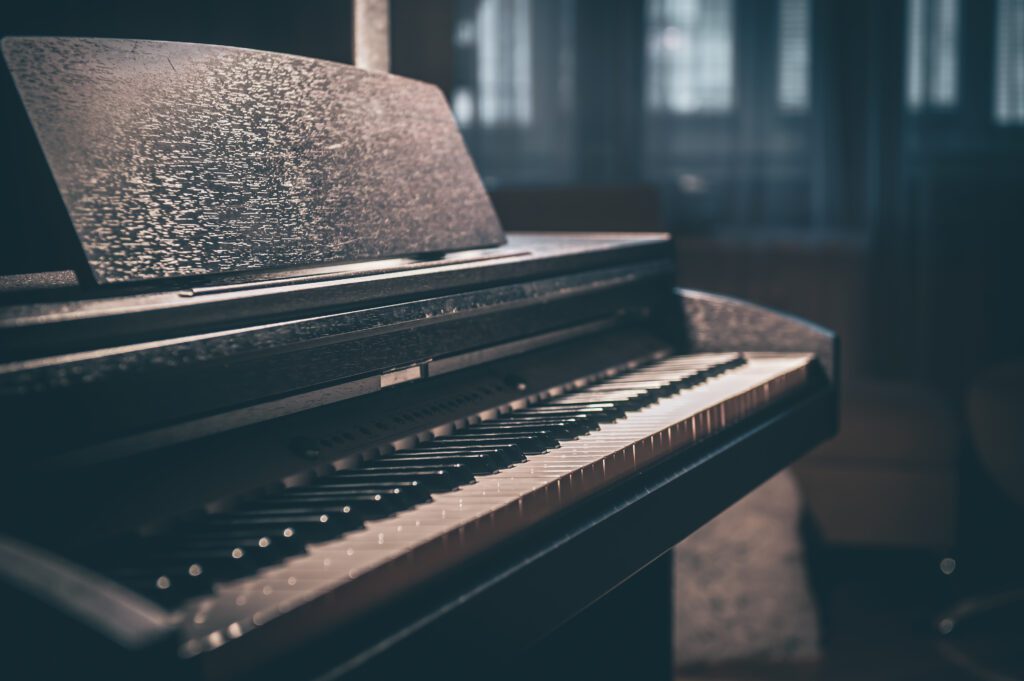
A Legacy That Never Fades
Piano’s enduring popularity and wide appeal have deeply influenced its role across various music genres. Over the years, it has become a symbol of musical tradition and innovation. Because of its versatility, the piano remains a favorite for composers, performers, and educators around the world.
From its invention in the early 1700s, the piano has undergone many changes. However, its core function has remained the same. It serves as a powerful medium for emotion, rhythm, and harmony. Pianists use its keys to bring their musical ideas to life with clarity and depth.
Even today, students often begin their music journey on the piano. Its layout makes it easier to understand musical structures, scales, and chords. Therefore, the piano continues to be an ideal instrument for both beginners and professionals.
A Bridge Between Genres
One reason the piano remains vital across diverse music genres is its remarkable adaptability. Unlike many instruments, the piano suits both traditional and modern styles. As a result, it forms a bridge between genres, cultures, and generations.
In one moment, a piano may lead a solemn classical sonata. In the next, it may back a lively jazz band. Because of this flexibility, the piano acts as a musical chameleon. It changes tone and technique depending on the setting, yet never loses its identity.
Whether used to compose, perform, or accompany, the piano remains a central figure in the music world. It adapts to change while holding on to its timeless beauty.
Classical Music and the Piano
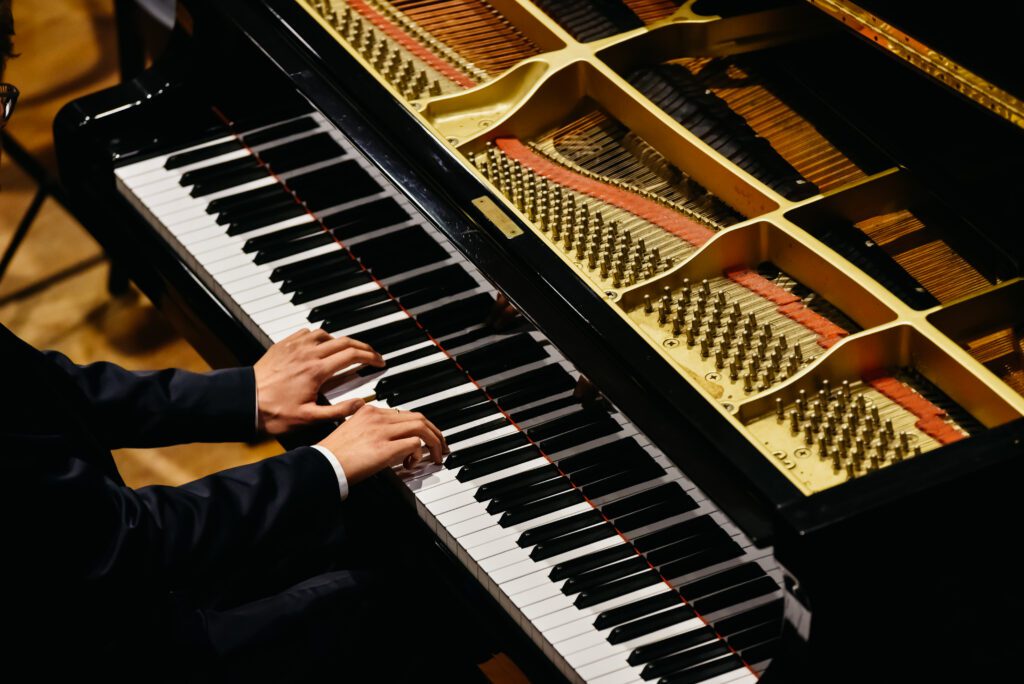
Where It All Began
The piano’s earliest expression across musical genres can be traced back to its roots in classical music. Since the 18th century, it has shaped the very foundation of Western musical art. Composers such as Haydn, Mozart, and Beethoven brought the piano into the spotlight. They used it not just as an accompaniment but as a powerful solo instrument.
Over time, the piano became a central force in the works of Romantic and modern composers. Artists like Chopin, Liszt, Brahms, and Debussy used the piano to push the limits of expression. Because of its dynamic range and rich tone, the piano became ideal for emotional storytelling.
The Power of Solo Piano Works
In classical music, solo piano compositions form an entire universe of sound. Sonatas, études, and preludes showcase the piano’s ability to speak on its own. Without other instruments, the piano can still produce melody, harmony, and rhythm at once.
This unique capability sets the piano apart. Because it acts like a mini orchestra, it allows composers to craft full musical ideas using only two hands. Solo piano works are often intense, expressive, and technically demanding.
Chamber and Orchestral Contributions
Across various music genres—especially classical—the piano also serves as a cornerstone in ensemble performances. In chamber music, it collaborates with strings and winds. Here, the piano brings balance and warmth to smaller groups.
In orchestras, the piano often appears in concertos. A concerto is a large-scale work where the piano plays against the full orchestra. During these performances, the pianist becomes both a collaborator and a soloist. As a result, the piano helps elevate the entire musical experience.
Teaching and Theory Tool
Because of its clear visual layout, the piano also plays an educational role. Music teachers use the piano to explain theory and harmony. Students hear intervals and chords more easily on the piano than on most instruments.
Due to this, the piano continues to hold its place in classrooms and conservatories. Its influence remains deep in the world of classical training and technique.
Jazz | Freedom and Improvisation
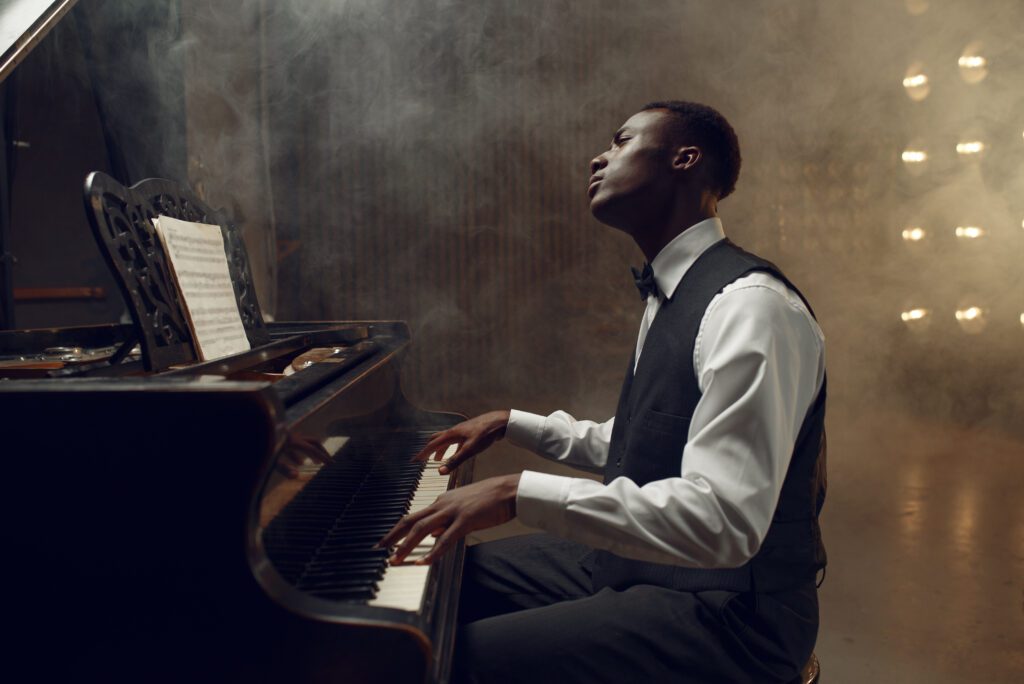
A New Voice Emerges
In jazz, the piano gains a new life. Instead of following strict rules, jazz invites freedom. Pianists get to explore emotion through improvisation. They react in real time, responding to other players and audience energy.
Jazz began in the early 20th century. It grew from blues, ragtime, and African rhythms. Over time, the piano became a key part of jazz ensembles. It helped define the genre’s harmonic structure and rhythmic groove.
Swing, Bebop, and Beyond
As jazz evolved, so did the piano’s role. During the swing era, pianists kept time with walking bass lines and light chords. They supported singers and big bands alike.
Then came bebop. This new style was fast, intricate, and bold. Pianists like Thelonious Monk and Bud Powell broke the rules. They used dissonance, speed, and space to surprise listeners. Because of them, the piano gained more freedom than ever before.
Modern jazz continues to innovate. Today, pianists blend styles like Latin, funk, and fusion into their playing. With each note, they expand what jazz piano can become.
The Art of Comping
One of the most important skills for jazz pianists is “comping.” This means accompanying a soloist with chords and rhythms. Rather than simply playing written music, jazz pianists create patterns on the spot.
They must listen carefully. They match the mood of the soloist, adjust dynamics, and find space in the music. Because of this interaction, jazz becomes a conversation — and the piano speaks with clarity and creativity.
Taking the Spotlight
In jazz, the piano is more than a support instrument. It often leads with solos that reflect the player’s personality. These solos can be wild, smooth, chaotic, or calm. Each pianist brings their own style, tone, and rhythm.
Legends like Bill Evans, Herbie Hancock, and Oscar Peterson shaped the sound of jazz piano. Their work shows how deeply expressive and varied the piano can be in this genre.
Blues | The Heart and Soul of Expression

A Sound Born from Emotion
In the realm of blues, the piano takes on a deeply emotional and expressive character across genres. Here, it speaks from the soul. Originating in the American South, blues music emerged from hardship, resilience, and raw emotion.
The piano helped bring this voice to life. It mirrored the aching vocals and guitar slides often heard in blues songs. Because of its expressive power, the piano became an essential storytelling tool.
The Twelve-Bar Tradition
One of the blues’ defining features is the twelve-bar blues progression. This structure provides a familiar framework for musicians. Piano players use it to build mood and drama.
With this structure, pianists repeat chord patterns with slight variations. This repetition makes the listener feel grounded. At the same time, small changes keep the sound fresh and engaging.
Because of its rhythmic strength, the piano sets the pulse. It balances simplicity with soulful expression in every bar.
Boogie-Woogie Piano
Boogie-woogie is a high-energy blues piano style. It became popular in the early 20th century. Pianists used fast left-hand bass lines and syncopated right-hand melodies.
This style gave blues a danceable groove. Because of its upbeat nature, boogie-woogie drew large crowds to clubs and gatherings. Artists like Meade “Lux” Lewis and Albert Ammons became stars with this style.
Today, you can still hear boogie-woogie influence in rock and roll piano playing.
Blues Piano as a Solo Voice
In the blues, the piano often plays solo. Pianists share their personal stories through their fingers. Using bends, slides, and gospel-inspired riffs, they build emotional tension.
Each note carries weight. Because of its dynamic range, the piano lets players whisper or shout with equal force. The piano, particularly in the blues, resonates deeply with the human heart across different music genres.
Pop Music | Versatility Meets Mainstream Appeal

The Piano in the Spotlight
Pop music thrives on catchy hooks and relatable themes, making the piano a natural fit across genres. In pop, it often plays a central role in songwriting and production.
From piano ballads to upbeat anthems, this instrument adds melody and emotion. Artists use it to build a connection with listeners. Because of its clarity and warmth, the piano shines both on stage and in the studio.
Iconic Pop Piano Moments
Many unforgettable pop songs feature the piano. Think of Adele’s “Someone Like You” or Elton John’s “Your Song.” These tracks capture emotion through simple yet powerful piano parts.
The piano provides more than just background chords. It leads the way. Because of this, pop pianists often become stars themselves. Their hands guide the sound and feeling of the entire song.
The Role of the Piano in Songwriting
Behind many hit songs, there’s a piano. Songwriters use it to test chord progressions, explore melodies, and shape structure. The piano offers an instant way to hear musical ideas come to life.
Because of this, it remains a favorite tool in songwriting sessions. Even in high-tech studios, the piano often sits in the center. Its simplicity allows for honest, creative expression.
Blending with Electronic Sounds
Pop continues to evolve, and the piano adapts. In today’s tracks, acoustic piano blends with synthesizers and beats. Producers layer piano sounds with digital textures.
Despite the tech-heavy setting, the piano still adds warmth and humanity. Because of this mix, pop music feels both modern and emotionally rich.
Whether leading a track or filling in subtle layers, the piano remains essential in pop production.
Rock and the Piano’s Edge

The Piano as an Amplifier of Emotion
In rock music, the piano adopts a bolder, more powerful edge that sets it apart across genres. Originally a background instrument, it has become a key part of many iconic rock bands. From Elton John to Billy Joel, the piano has been used to amplify the raw emotion of rock music.
Unlike classical or jazz, rock music often uses the piano to create dynamic contrasts. With strong, rhythmic chords and the occasional melodic line, rock pianists have made the instrument their own. The result is an exciting fusion of melody and power.
Iconic Rock Piano Players
Some of rock’s greatest legends are known for their piano playing. Elton John’s piano-driven hits like “Rocket Man” and “Bennie and the Jets” became anthems. His use of the piano shaped the sound of classic rock in ways that forever altered the genre.
Billy Joel’s “Piano Man” is another example of how the piano becomes the heart of rock. His music blends pop melodies with rock’s intensity. It shows how the piano can drive the song while creating a memorable, sing-along moment.
The Piano’s Role in Hard Rock and Progressive Rock
In harder rock genres, the piano still plays an important role. Bands like Queen often used the piano for dramatic, sweeping arrangements. Freddie Mercury’s use of the piano in “Bohemian Rhapsody” is a prime example of its versatility.
In progressive rock, piano solos can take center stage. The intricate, complex melodies highlight the piano’s role in expanding rock music’s musical boundaries.
Despite the guitar often being the focal point in rock, the piano continues to add depth, emotion, and variety.
Piano and Modern Rock Fusion
In today’s rock landscape, the piano blends seamlessly with electronic elements and powerful guitar riffs. Bands like Coldplay and The Killers use the piano to enhance their distinctive sound.
The piano’s versatility allows modern rock musicians to experiment with different tones and textures. Whether adding atmospheric layers or creating bold, dynamic solos, the piano remains a foundational instrument in rock music.
Film Music | Storytelling with Keys
The Power of Music in Cinema
Film scores are central to storytelling. The piano frequently holds a central role in film music, resonating across a variety of genres. With its broad range and emotive capabilities, the piano enhances the emotional landscape of films. It can build suspense, convey joy, or evoke sadness.
From epic adventures to intimate dramas, the piano’s versatility helps create the mood. Composers use the piano to capture emotions that are sometimes difficult to express through dialogue alone.
Piano as the Heart of Iconic Scores
Several film scores are unforgettable because of their piano parts. John Williams’ “Schindler’s List” theme is hauntingly beautiful, with the piano conveying the sorrow and gravitas of the film’s subject matter.
Another example is the score for “The Piano” by Michael Nyman. This minimalist, piano-driven composition perfectly mirrors the film’s introspective and emotional themes. The piano becomes the voice of the protagonist, communicating what words cannot.
The Piano’s Role in Animation and Family Films
In animated and family films, the piano often brings warmth and magic to the story. The music underscores the emotions of the characters, amplifying their journey.
Movies like Disney’s “The Lion King” and “Beauty and the Beast” use piano compositions to enhance the emotional beats. The piano elevates these heartwarming and dramatic moments, adding to the timeless quality of the films.
Building Atmosphere Through Piano in Film
Piano music also helps create atmosphere in films. Whether it’s a slow, somber piece to accompany a reflective scene or a light, playful tune for a happy moment, the piano shapes the audience’s perception.
It can be quiet and introspective or bold and sweeping. Directors and composers use the piano’s capacity to evoke deep emotions to guide the audience through the story. Its presence in film underscores its role as a universal instrument that communicates across genres.
Electronic and Experimental Genres
The Evolution of the Piano in Electronic Music
In electronic and experimental music, the piano transforms into a unique sonic element, pushing the boundaries across genres. While traditional piano playing relies on acoustic sounds, electronic music often manipulates these sounds using technology. The piano’s role evolves as it blends with synthesized sounds and digital effects.
In electronic music, the piano creates new textures and atmospheres. Producers use electronic keyboards, MIDI controllers, and digital software to craft unique piano sounds. These electronic versions of the piano become integral to the genre’s experimental nature.
Creating Atmosphere and Texture with Piano
In experimental music, the piano often takes on a more ambient role. Artists use it to create a soundscape rather than a melody-driven piece. This atmospheric quality of the piano adds depth and richness to electronic tracks.
For example, artists like Brian Eno have used the piano’s simple chords and resonating sounds to evoke emotion and atmosphere. Through digital manipulation, the piano becomes more than just an instrument—it becomes a canvas for sound exploration.
The Role of Piano in Ambient and Downtempo Music
In genres like ambient and downtempo, the piano’s role is often more meditative. Here, the piano is used sparingly, creating long, sustained notes and delicate melodies that evoke a sense of calm and introspection.
Piano melodies in ambient music, often slowed down or manipulated digitally, blend with electronic pads and atmospheric sounds. The result is a soothing, ethereal soundscape where the piano remains a powerful yet subtle presence.
Piano in Experimental Sound Design
Experimental music thrives on pushing boundaries, and the piano plays an essential role. In this genre, artists experiment with non-traditional playing techniques, such as prepared piano or using piano strings as sound sources. These techniques allow the piano to produce unconventional, otherworldly sounds.
Artists like John Cage and Philip Glass have shown how the piano can break free from its traditional role. Through new playing methods and experimental sound design, the piano becomes a tool for artistic expression, no longer confined to the classical or jazz realms.
Gospel and Worship Music
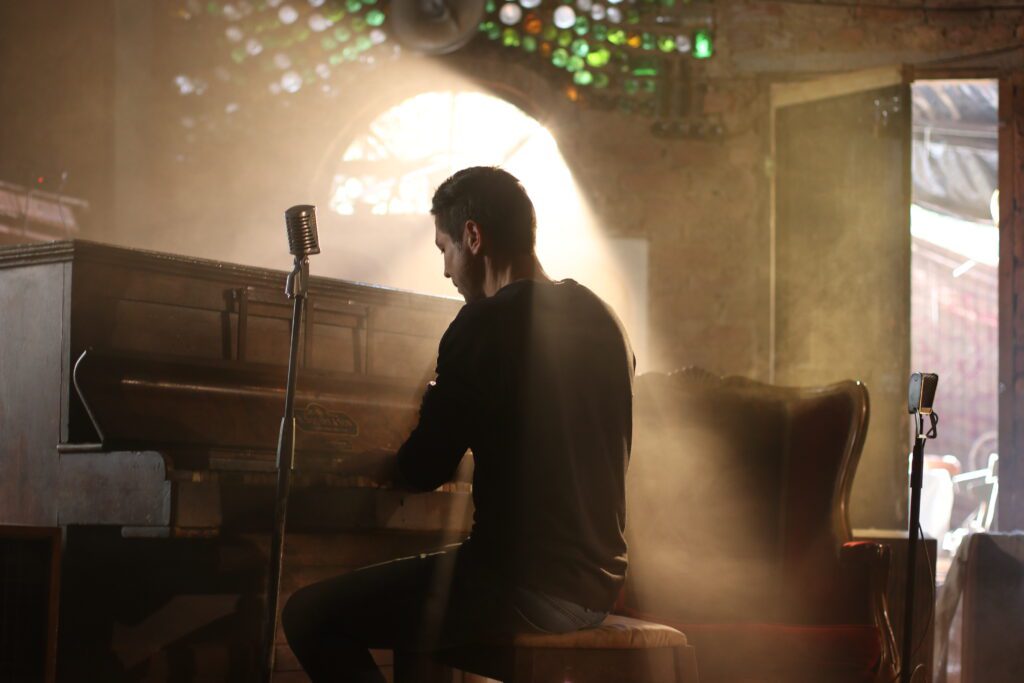
The Piano’s Role in Worship and Praise
In gospel and worship music, the piano holds a special, revered place, shaping the sound and atmosphere of these genres. In churches and religious services, the piano helps convey the spiritual emotion of the music. It provides the melodic foundation, allowing worshippers to connect deeply with the message of the song.
The piano in gospel music often has an intense, emotive quality. Gospel pianists use strong chords and rapid, rhythmic patterns to create a sense of urgency and passion. This style of playing often encourages participation and lifts the spirit of the congregation.
The Power of Gospel Piano Style
Gospel music is known for its complex, soulful piano style. Pianists play with intricate runs, improvisation, and dynamic changes in tempo. This style is both technical and deeply expressive.
Gospel pianists often play by ear, adding their personal touch to the arrangement. They combine powerful chord progressions with sweeping arpeggios, creating a rich, emotional experience.
Many influential gospel pianists, like Thomas A. Dorsey and Sister Rosetta Tharpe, shaped the genre. Their piano playing elevated gospel music, blending traditional hymns with elements of blues and jazz, making it accessible and relatable to broader audiences.
The Piano in Contemporary Worship
In contemporary worship music, the piano continues to serve as a central instrument. It provides both harmonic structure and emotional depth. Often, the piano is paired with other instruments like drums and guitars to create a modern, dynamic worship experience.
Worship leaders use the piano to guide the congregation through various tempos and emotional states. It sets the tone for prayerful moments and also supports uplifting, joyous songs. Because of its flexibility, the piano can serve as the heart of worship music, whether in a solo role or as part of a band.
The Piano’s Emotional Expression in Hymns and Spirituals
Hymns and spirituals, with their rich history, use the piano to convey powerful emotions. The piano’s ability to evoke feelings of sorrow, joy, and hope is crucial in these songs.
In traditional hymns, the piano provides a steady, supportive foundation. In spirituals, it carries the soul-stirring melodies, enhancing the emotional delivery.
Piano in gospel and worship music becomes an instrument of prayer, reflection, and praise. It helps convey the deep connection between the performer, the congregation, and their faith.
The Piano’s Universal Appeal

A Timeless Instrument for All Ages
The piano has carved out a unique place in music history across various genres. Its appeal transcends age, culture, and time. Whether played by young learners, seasoned musicians, or pop icons, the piano remains a universally loved instrument. It is the foundation for many styles of music, offering versatility and accessibility. From classical compositions to modern pop hits, the piano adapts to every genre, making it an instrument for everyone.
The Piano’s Accessibility to Beginners and Experts
One of the reasons for the piano’s universal appeal is its accessibility. Unlike some instruments that require extensive training to produce a pleasant sound, the piano offers instant gratification. Beginners can easily play basic melodies, while more advanced players can explore complex techniques. This combination of simplicity and depth makes it an ideal choice for musicians of all skill levels.
For beginners, the piano’s wide range of keys and its visual layout make learning easier. Students can immediately see the relationship between notes, making music theory more intuitive. As players advance, the piano allows for a deeper exploration of harmony, rhythm, and improvisation, offering limitless potential for expression.
A Versatile Instrument Across Cultures
The piano’s universal appeal is also due to its ability to blend into various cultural and musical traditions. Across the world, different genres of music incorporate the piano to express local flavors and global influences. From Western classical music to traditional Chinese pieces and African-inspired jazz, the piano’s ability to adapt makes it a truly universal instrument.
In countries like India, the piano is used to add an element of Western influence in traditional music. Meanwhile, in the Americas, it plays a significant role in genres such as jazz, blues, and pop. The piano’s rich history and its ongoing evolution in different musical contexts prove that it has a place in every culture.
The Emotional Impact of the Piano
The piano’s power lies in its emotional depth. It can convey a wide array of emotions—from joy and excitement to sadness and nostalgia. The ability to express such a broad range of emotions makes the piano a beloved instrument for both performers and audiences.
In genres like gospel and classical music, the piano becomes a vehicle for emotional storytelling. Its expressive dynamics and rich tonal qualities enable musicians to evoke powerful feelings in listeners. The piano can tug at the heartstrings, creating a connection between the artist and the audience that words alone cannot.
The piano’s emotional impact is not just about the notes played, but also about the spaces between them. The pauses, the soft touches, and the crescendos all contribute to a musical experience that is both profound and personal.
Piano and Collaboration in Music
Another reason for the piano’s universal appeal is its ability to collaborate seamlessly with other instruments. It serves as the backbone for many ensembles, whether it’s accompanying vocalists, playing with string instruments, or blending with electronic beats. The piano’s versatility makes it an ideal partner for musical collaboration.
In genres like jazz, the piano is often the lead instrument in small combos, while in orchestras, it plays a vital supporting role. In pop music, it provides the harmonic structure, guiding the direction of the song. The piano’s ability to adapt to various settings makes it a beloved tool for musicians around the world.
Conclusion | The Piano’s Lasting Influence
The piano stands as a symbol of versatility, emotion, and universal appeal across various music genres. Its role in shaping the sound of various musical styles, from classical to pop, from jazz to gospel, is irreplaceable. Whether in a grand concert hall, a small jazz club, or a home studio, the piano remains at the heart of music-making.
The piano’s ability to blend seamlessly into different cultures and genres proves its timeless relevance. It continues to inspire musicians, songwriters, and listeners worldwide. As both an emotional vehicle and a tool for collaboration, the piano will undoubtedly remain a cornerstone of music for generations to come.
By offering a combination of accessibility, emotional depth, and endless creative possibilities, the piano has earned its place as one of the most beloved and universally appreciated instruments across the globe. Explore the world of Piano in our Piano Lessons Online.
Related Blogs
How to Practice Piano Effectively: Make the Most of Your Time
The melody lingers, a whisper from your childhood – a half-remembered piano piece, the echo of music lessons long forgotten. In the quiet corners of your adult life, amidst the demands of work, family, and commitments, a yearning for music stirs.


